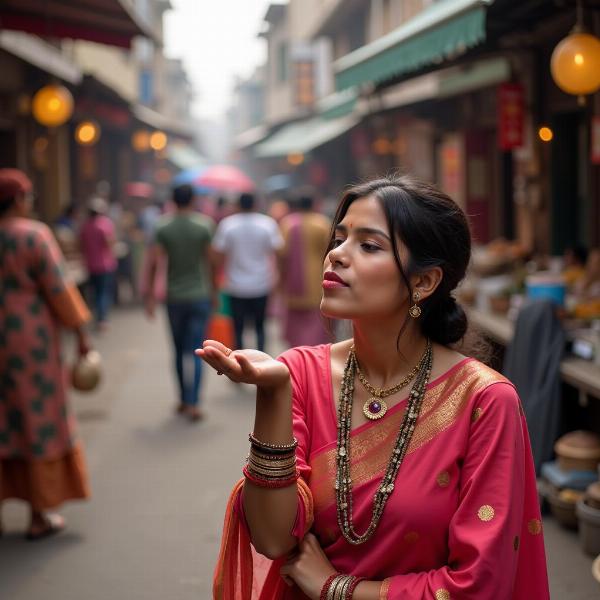A flying kiss, a gesture as light as air, carries a world of meaning, especially in a culturally rich country like India. But what exactly does “flying kiss meaning in Hindi” translate to? This article delves into the nuances of this affectionate gesture, exploring its cultural context, various interpretations, and its evolving significance in modern Indian society. We’ll uncover the Hindi terms associated with a flying kiss, how it’s perceived across different generations, and its place in both traditional and contemporary Indian culture.
Understanding the Cultural Nuances of a Flying Kiss in India
In India, physical touch is often reserved for close family members. Public displays of affection between couples, while becoming more common in urban areas, are still generally subtle. The flying kiss, therefore, provides a perfect compromise—a way to express affection without direct physical contact. It allows individuals to convey warmth, fondness, and even playful teasing, all while respecting cultural boundaries.
 Flying Kiss in India
Flying Kiss in India
What Does “Flying Kiss” Actually Mean in Hindi?
While there isn’t a single, direct Hindi translation for “flying kiss,” several phrases capture its essence. “Udta chumban” (उड़ता चुम्बन) is a literal translation, combining “udta” (flying) and “chumban” (kiss). Other terms, such as “hawa mein chumban” (हवा में चुम्बन – kiss in the air) or “door se pyar” (दूर से प्यार – love from afar), are also used to convey the same sentiment. The choice of phrase often depends on the region and the specific context.
How is a Flying Kiss Perceived Across Generations?
The older generation in India might view a flying kiss as a somewhat novel expression, perhaps influenced by Western culture. However, they often understand it as a playful gesture of affection, especially within the family. For younger generations, the flying kiss is a common and readily accepted form of expressing affection, often used among friends, family, and even romantic partners.
The Flying Kiss in Bollywood and Popular Culture
Bollywood, India’s vibrant film industry, has certainly played a role in popularizing the flying kiss. It’s a common sight in movies and music videos, often used to portray romantic interest or playful flirtation. This exposure has contributed to the widespread acceptance and understanding of the gesture across the country.
Flying Kiss Etiquette: Dos and Don’ts
- Do: Use it with people you have a warm relationship with.
- Don’t: Use it in formal settings or with strangers.
- Do: Consider your audience and the cultural context.
- Don’t: Overuse it, as it can lose its meaning.
Expert Insights on the Flying Kiss
Dr. Anjali Sharma, a sociologist specializing in Indian culture, notes: “The flying kiss is a fascinating example of how cultural expressions evolve. It’s a gesture that blends tradition with modernity, offering a nuanced way to express affection within the framework of Indian societal norms.”
Rahul Kapoor, a renowned Hindi linguist, adds: “The lack of a single, direct translation for ‘flying kiss’ in Hindi reflects the evolving nature of language and its ability to adapt to new cultural expressions.”
Conclusion: The Flying Kiss – A Universal Language of Affection
The flying kiss, whether you call it “udta chumban” or “hawa mein chumban,” has found a unique place in Indian culture. It serves as a lighthearted and culturally appropriate way to express affection, bridging the gap between generations and reflecting the evolving dynamics of Indian society. It’s a gesture that speaks volumes without uttering a word, showcasing the power of non-verbal communication in conveying emotions across cultures.
FAQ
-
What is the most common Hindi word for “flying kiss”? “Udta chumban” (उड़ता चुम्बन) is a commonly used term.
-
Is it considered disrespectful to give a flying kiss in India? Not generally, especially within family and friends circles. However, context is important.
-
Is the flying kiss a recent phenomenon in India? While it gained popularity through media, similar expressions of affection have existed in different forms throughout Indian history.
-
Do people of all ages use the flying kiss in India? It’s more common among younger generations, but older generations are becoming increasingly familiar with it.
-
Is the flying kiss seen as a romantic gesture in India? It can be, but it’s also used as a general expression of affection among friends and family.
-
How is the flying kiss depicted in Bollywood movies? It’s often used to portray romantic interest, playful flirting, or familial affection.
-
Are there any regional variations in the meaning or interpretation of the flying kiss in India? While the core meaning remains the same, specific phrases and interpretations might vary slightly across different regions.
Meaning-Hindi.in is your premier destination for professional Hindi translation services, catering to a wide range of needs, from business and legal documents to technical manuals and website localization. Our expert linguists ensure accurate and culturally sensitive translations, bridging the communication gap between languages and cultures. For all your Hindi translation needs, contact us at [email protected] or call us at +91 11-4502-7584. Meaning-Hindi.in offers unparalleled expertise in business, legal, technical, website, educational, and specialized translation services, guaranteeing quality and precision in every project. Contact us today for a tailored solution to your translation requirements.